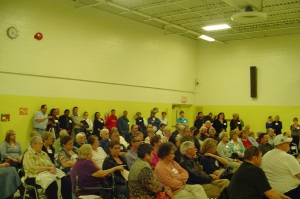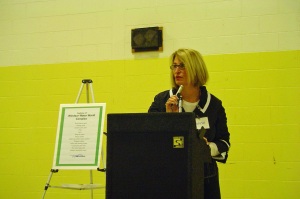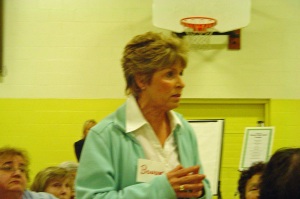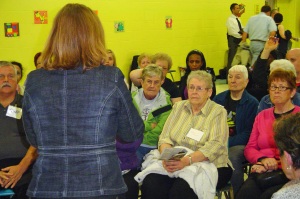By Paul Chislett
On April 27th, it quickly became apparent that the crowd of about 80 people attending the city led meeting of the Water World pool facility, primarily from the Glengarry Housing Development, did not want to see their pool close. City council has voted to study the construction of a 50 meter pool complex that would be built farther west onRiverside drive.

Concerned citizens pack hall
Residents where neighbourhood pools exist are fearful the city will close neighbourhood facilities forcing everyone from seniors, children, and the disabled to share a facility primarily aimed at athletes and tourists. As a result of concerns, neighbourhood meetings were arranged for the Glengarry community, and one for those who rely on Adie Knox in May. At the meeting it was quickly evident that city administrators had an agenda meant to diffuse citizen opposition to a pool closure at Water World. Even though the residents were adamant that the Water World pool is the heart and soul of the Glengarry housing community and should not close, the city officials proceeded with a process that included breaking into smaller groups and discussing three pre-arranged questions formulated by city officials without input from the community.
Ronna Warsh, General Manager of Social & Health Services for Windsor, facilitated the meeting on behalf of the mayor and council. Four councilors also attended the meeting: Fulvio Valentinis who represents the ward Water World sits in, Alan Halberstadt of Ward 4, Ed Sleiman, Ward 5, and Ron Jones, Ward 2. Warsh addressed the citizens stressing that no decision has been made on a new pool being built, and that she and her team were there to hear what residents had to say. However, at one point during an exchange with residents Warsh stated that “city council could have deliberated this without hearing your voices, so good for them they are in the room, they are hearing your voices.” This was an astonishing statement to hear since city councilors are paid to listen to the concerns of citizens. Residents were encouraged to consider the pool as only one element of a multi-use facility. If the pool were gone, the other service elements and the building would remain and possibly be enhanced. The three pre-arranged questions put to the citizens were: ‘What do you like that happens inside and outside of the facility’? ‘If council were to close the pool what could you dream about that would replace it’? And ‘what ideas do you have for new programs that would use the pool space’? While small group discussions are a valuable part of a consultation process, it seemed in this case that small groups were calculated to better control the agenda of city officials, and that agenda was to deflect discussion from the pool closing and instead fabricate consensus for the closure. Citizen opposition was anticipated and steps were taken to control the outcome of the meeting while giving residents the sense they had contributed to the process. It took some doing for Warsh to convince citizens to move into small groups as there was resistance to her agenda. People responded with a resounding No! when asked if they would go to another facility onRiverside. Nevertheless, in a spirit of cooperation, the residents moved into five groups to have discussions.

Ronna Warsh addresses citizens
When the main group reconvened, it was clear to Warsh that “this pool is a huge, important asset” for the citizens. Out of 18 in her group, only two would take their family to the new facility. Common themes in all groups were that many residents have limited mobility and count on the pool being close to where they live, that community cohesiveness is built and maintained by the proximity of the pool, and that seniors, children, and disabled people count on this facility. Bonnie Bailey, a tireless advocate for the facility and former recreation assistant to the manager of Water World, has no doubt that the new pool complex being proposed is needed. However, it will primarily serve athletes and tourists. She was adamant that children, seniors, and disabled people would not be able to access nor afford the new pool facility. The smaller size neighbourhood facilities such as Water World are there to serve residents, while the proposed pool complex would serve a specialized clientele and non-residents. Bailey was fearful about the dislocation and disintegration of community that would occur with one pool facility. For this observer, a world class city would include both a large pool complex as well as accessible and affordable neighbourhood pools and fitness facilities.

Bonnie Bailey voices concerns in support of Water World pool
In his remarks, Councilor Valentinis warned that those opposed to a pool closure must be able to prove why it is needed, rather than simply say they want the pool, end of discussion. Valentinis said that when it comes to council, other councilors will say that they don’t have such a pool in their area so why is Glengarry so special? Obviously not allWindsorneighbourhoods are socially and economically equal. Other neighbourhoods are better off economically and have greater mobility, so a neighborhood pool is not considered a necessity the way it is in Glengarry. Also, there was a definite sense that the city administrators feel they are stuck with operating costs for Water World since the casino paid for it to be built. Is the city now trying to railroad Glengarry residents into giving up their pool so Mayor Francis can put another feather in his cap for his vision of economic development? Is the city going to tell Glengarry residents they are simply not entitled to such a facility in their neighbourhood because there isn’t one in all neighbourhoods? Ronna Warsh stated that she heard very clearly that residents do not want their pool closed, and that the remarks recorded in the discussion groups will be included in the business case to be presented to council very soon. That business case will include the $700,000 needed to keep Water World open as is. The fight, therefore, to keep Water World open has just begun. Glengarry residents may have had their say, but if they leave the process in the hands of city administrators who only see numbers, this pool will close.

Barbara Pellarin listens intently
The city led consultations were not a participatory democratic model. While Glengarry resident Barbara Pellarin did feel the group discussion was a good idea and that her voice was heard, she remains doubtful that her concerns will sway decision makers on council. She is right to be apprehensive. Ward 3 residents need to be pro-active about council’s agenda for Water World. Residents would do well to form a citizen led neighbourhood council which can put together an air tight case for Water World and build links with other citizens to resist council’s ill-conceived notions of progress.
A version of this article appears in the May issue of The Scoop, Windsor’s alternative for news and views.

